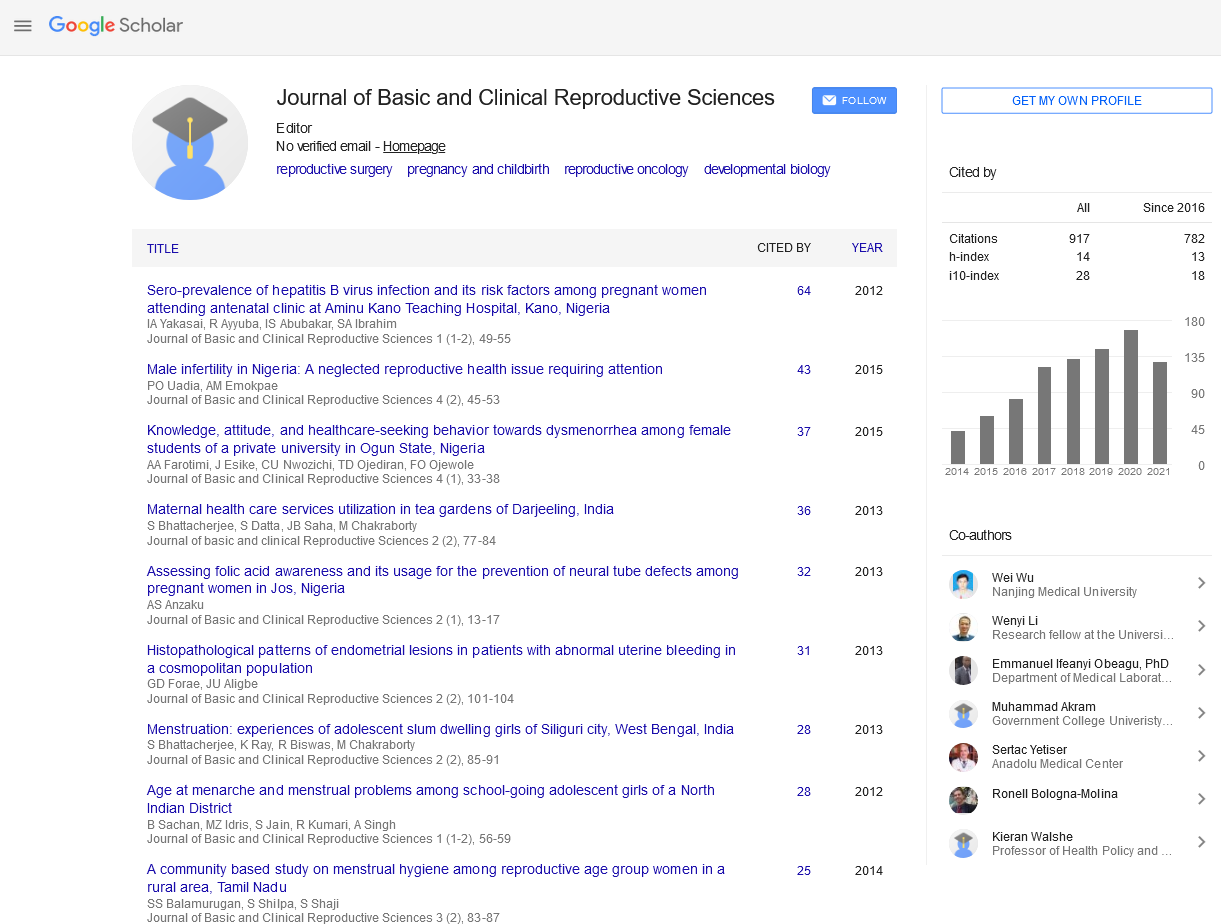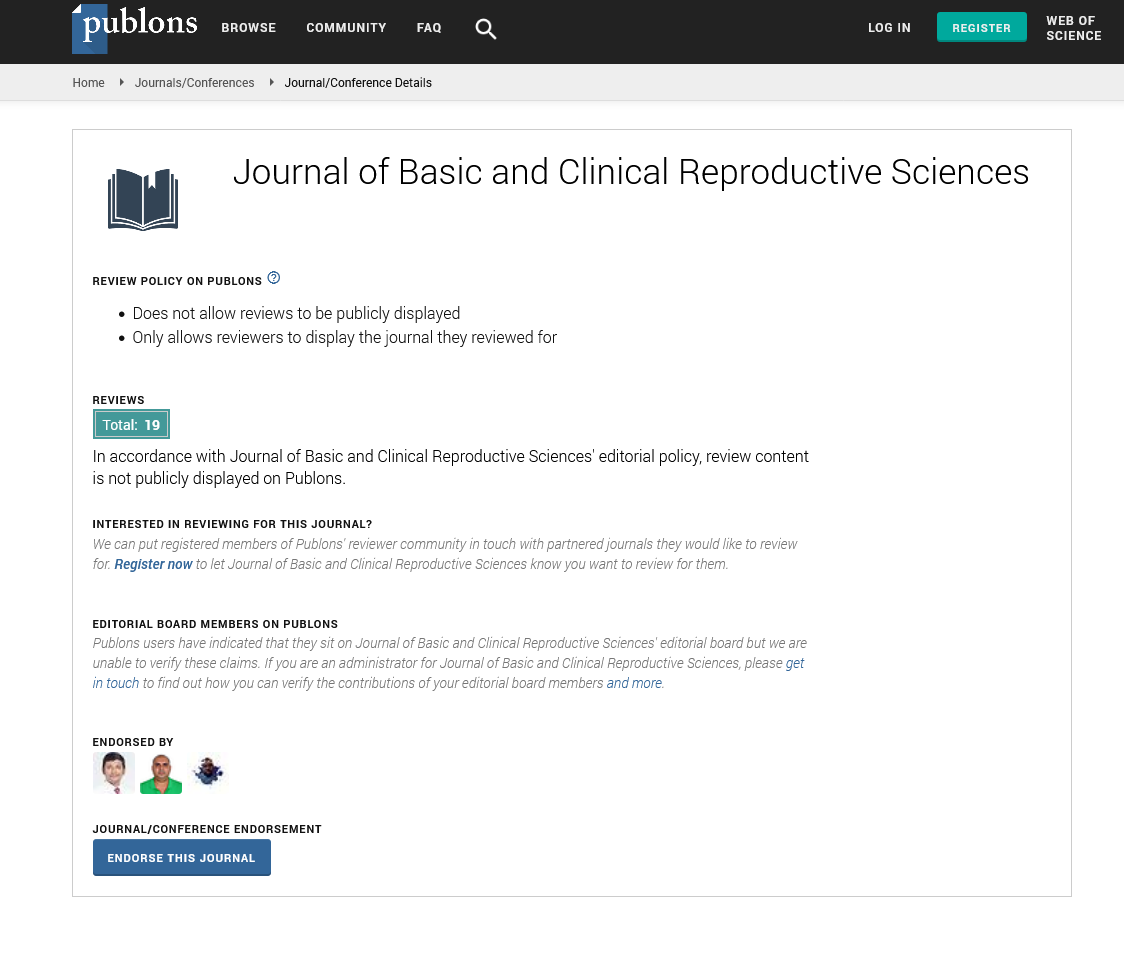Short communication - Journal of Basic and Clinical Reproductive Sciences (2023) Volume 12, Issue 3
An Overview on Fetal Anatomy, Growth and its Developments
Received: 04-Jun-2023, Manuscript No. JBCRS-23-101118; Editor assigned: 06-Jun-2023, Pre QC No. JBCRS-23-101118 (PQ); Reviewed: 20-Jun-2023 QC No. JBCRS-23-101118; Revised: 27-Jun-2023, Manuscript No. JBCRS-23-101118 (R); Published: 04-Jun-2023
This open-access article is distributed under the terms of the Creative Commons Attribution Non-Commercial License (CC BY-NC) (http://creativecommons.org/licenses/by-nc/4.0/), which permits reuse, distribution and reproduction of the article, provided that the original work is properly cited and the reuse is restricted to noncommercial purposes. For commercial reuse, contact reprints@pulsus.com
Description
A human life’s development is a remarkable and amazing process. A tiny embryo develops into a sophisticated organism within the womb. Fetal anatomy, the study of the processes and structures that appear during Fetal development. The set off voyage through the wonders of Fetal anatomy in this article, learning how various organs and systems develop and work, and appreciating the astounding elegance and complexity of life at its earliest beginnings.
The Early Embryo’s Development
A single cell known as a zygote is created when an egg and sperm combine to start the process of life. The zygote rapidly divides its cells, eventually producing a hollow ball of cells known as a blastocyst. Three germ layers the ectoderm, mesoderm, and endoderm develop inside the blastocyst [1]. During Fetal development, each layer gives rise to particular tissues and organs. The neurological system, skin, and sensory organs are all formed by the ectoderm. Mesoderm is a component of bones, muscles, and the circulatory system. Last but not least, the endoderm gives rise to the respiratory and digestive systems [2].
Establishing the foundations of organogenesis
Organ creation, or organogenesis, takes place during the embryonic period. The development of vital organs such the heart, lungs, brain, liver, and kidneys can be seen. By the end of the third week, the heart, the first organ to form, begins to beat. The formation of blood vessels and vital nutrients and oxygen are delivered to sustain growth [3].
The nervous system grows when the ectoderm gives rise to the brain and spinal cord. Neurons, the basic units of the nervous system, start to link together and form the foundation for later brain development [4].
The development of the respiratory system starts at the same time. A straightforward tube-like structure first develops, then differentiates into the lungs, bronchi, and trachea. The lungs continue to grow and mature while a Fetus but are not functioning until after delivery [5]. Beginning with the growth of the mouth, oesophagus, and stomach, the digestive system arises from the endoderm. The intestines lengthen and fold as the Fetus develops, preparing them for nutrient absorption after birth [6]. During the embryonic stage and the skeletal system which is made up of bones and cartilage starts to form. The skeleton is initially mostly composed of soft cartilage, which eventually turns into bone through a process known as ossification [7].
The Fetal development’s late stages
The Fetus experiences tremendous growth and development as it transitions into the Fetal period. To get ready for life outside the womb, the organs continue to develop and become completely functional [8]. As the alveoli, or tiny air sacs responsible for oxygen exchange, grow in the lungs, the respiratory system matures further. The Fetus endures a tremendous growth in size and weight throughout the third trimester. The enormous growth and development of the brain facilitates the development of sensory perceptions and motor abilities [9]. The circulatory system develops to meet the expanding requirements of the developing Fetus. The blood arteries enlarge and grow, and the heart gets stronger, pumping oxygenated blood throughout the body. The reproductive organs also differentiate at this time. In males, the genitals descend into the scrotum, and in females, the ovaries grow inside the pelvis. The external genitalia also develop, identifying the gender of the Fetus [10].
Conclusion
The process of Fetal growth is a remarkable testament to life’s miracles. The process of organogenesis and maturation, which takes a human from a single cell to a fully developed creature, is evidence of the detailed beauty and complexity of human anatomy. This can appreciate the delicateness and interconnection of the many organs and systems by comprehending the complex stages of Fetal development. The comprehension of human life grows to solve the riddles of Fetal anatomy and open the door for improvements in medicine that promote the health and wellbeing of pregnant women as well as their future offspring.
References
- Bourne G. The foetal membranes: A review of the anatomy of normal amnion and chorion and some aspects of their function. Postgrad Med J. 1962; 38(438):193.
- Van der Schoot P. The name cranial ovarian suspensory ligaments in mammalian anatomy should be used only to indicate the structures derived from the foetal cranial mesonephric and gonadal ligaments. Anat Rec. 1993; 237(3): 434-438.
- Wintour EM, Laurence BM, Lingwood BE. Anatomy, physiology and pathology of the amniotic and allantoic compartments in the sheep and cow. AVJ. 1986; 63(7): 216-221.
- Briedis J, Jackson IT. The anatomy of the philtrum: observations made on dissections in the normal lip. Br. J. Plast. Surg. 1981; 34(2): 128-132.
- Begg RC. The urachus: its anatomy, histology and development. J. Anat. 1930; 64(Pt 2): 170.
- Burdan F, Szumiło J, Dudka J, et al. Morphological studies in modern teratological investigations. Folia morphol. 2005; 64(1): 1-8.
- Bourne GL. The anatomy of the human amnion and chorion. Proceedings of the Royal Society of Medicine. 1966; 59(11): 1127-1128.
[Crossref][Google Scholar] [PubMed]
- Pedersen HE, Blunck CF, Gardner E. The anatomy of lumbosacral posterior rami and meningeal branches of spinal nerves (sinu-vertebral nerves): with an experimental study of their functions. JBJS; 38(2): 377-391.
- Wallner C, Dabhoiwala NF, DeRuiter MC, et al. The anatomical components of urinary continence. Eur. Urol. Oncol. 2009; 55(4): 932-944.
[Crossref][Google Scholar] [PubMed]
- Parsons FG. Notes on the anatomy of an anencephalous foetus having three arms and three lower limbs. IJCAP. 1896; 30(Pt 2): 238.


